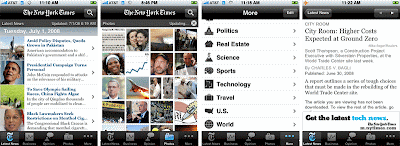On March 28, 2011 the New York Times launched, in the US (on the 24th in Canada), “digital subscriptions,” for online viewing and applications for smart phones and tablets. This program allows users to access twenty articles per month at no charge, but after that, online readers must pay a monthly subscription fee to access more content. Mobile and tablet users will be able to access the Top News section for free and for extra content they will need a subscription; a “freemium”- free pricing strategy. (Also, good news! The free twenty article limit doesn’t include articles linked through blogs or social media such as Facebook or Twitter.)
If a user is already a home subscriber, the digital edition is complementary. For non-delivery subscribers, one can pay $15 per month for access to the paper online or via the mobile app.
Tablet users will have to pay $20 per month; also offered is a “combined” $35 subscription option for unlimited access on any and all devices. That plan would bring the annual price for a New York Times subscription to over $400.
These plans don’t include e-reader editions on Amazon’s Kindle, Barnes & Noble’s Nook, the Kobo Reader or the Sony Reader. Also, none of the crossword or Sudoku apps are included.
Arthur Sulzberger, Jr., chairman of The New York Times Company and publisher of the New York Times said “Today marks a significant transition for The Times, an important day in our 159-year history of evolution and reinvention.” He continued, “Our decision to being charging for digital access will result in another source of revenue, strengthening our ability to continue to invest in the journalism and digital innovation on which our readers have come to depend. This move will enhance The Time’s position as a source of trustworthy news, information and high-quality opinion for many years to come.”
About the apps:
The New York Times offers a variety of apps for smart phones (iPhone, Blackberry, Android, Palm Pre) and tablets including:
- The NYTimes app: Brings news with blogs, videos and slideshows wherever is convenient for the user. It is easy to share articles, photos, and videos via email, Facebook, Twitter, etc.
- The New York Times Real Estate app: Combines in-depth property search tools and mobile features to search for homes.
- The Scoop: NYC App: A guide to NYC from the staff at The New York Times. This features restaurants, bars, events, and experiences.
- The New York Times Crosswords: self-explanatory.
- The New York Times Sudoku: self-explanatory.
- Learning English With The New York Times: English as a second language speakers can improve reading and listening skills, as well as learn new vocabulary.
Kristin M. Mason, manager of communications at The New York Times Co., New York., explains that “The New York Times is launching a digital subscriptions model. This plan allows us to develop a new source of revenue that will strengthen our ability to continue our journalistic mission and digital innovation, while enabling us to maintain the large audience that supports our robust advertising business.”
For this campaign, The New York Times is not only targeting those who already have a deliverable subscription, but businessmen on-the-go who use are already on their phones and tablets. This app is also designed to reach younger audiences, who now might be more inclined to read the news because they can access it from a mobile device. Also, the Times needs another way to increase revenue and stay on top of their competitors.
While I do not have a smart phone or tablet, so I am unable to experience this app first-hand, reviews of the application itself have been strong, while the reviews of the sign-up process aren’t exactly positive. One blogger explains how tedious it is: “It requires users to enter a credit card number, security code and billing address via touch screen keyboard; it’s not as quick as Apple’s one-click subscription process.” However, Apple has a June 30 deadline for publishers to offer in-app subscriptions via iTunes. So one will be able to use the one-click subscription option, however Times has a couple months to sign up subscribers with its own e-commerce system before it must offer Apple’s payment system and consequently give up 30% of its revenue.
Sources:
http://latimesblogs.latimes.com/technology/2011/03/the-new-york-times-will-charge-for-its-online-content-starting-march-28.html











